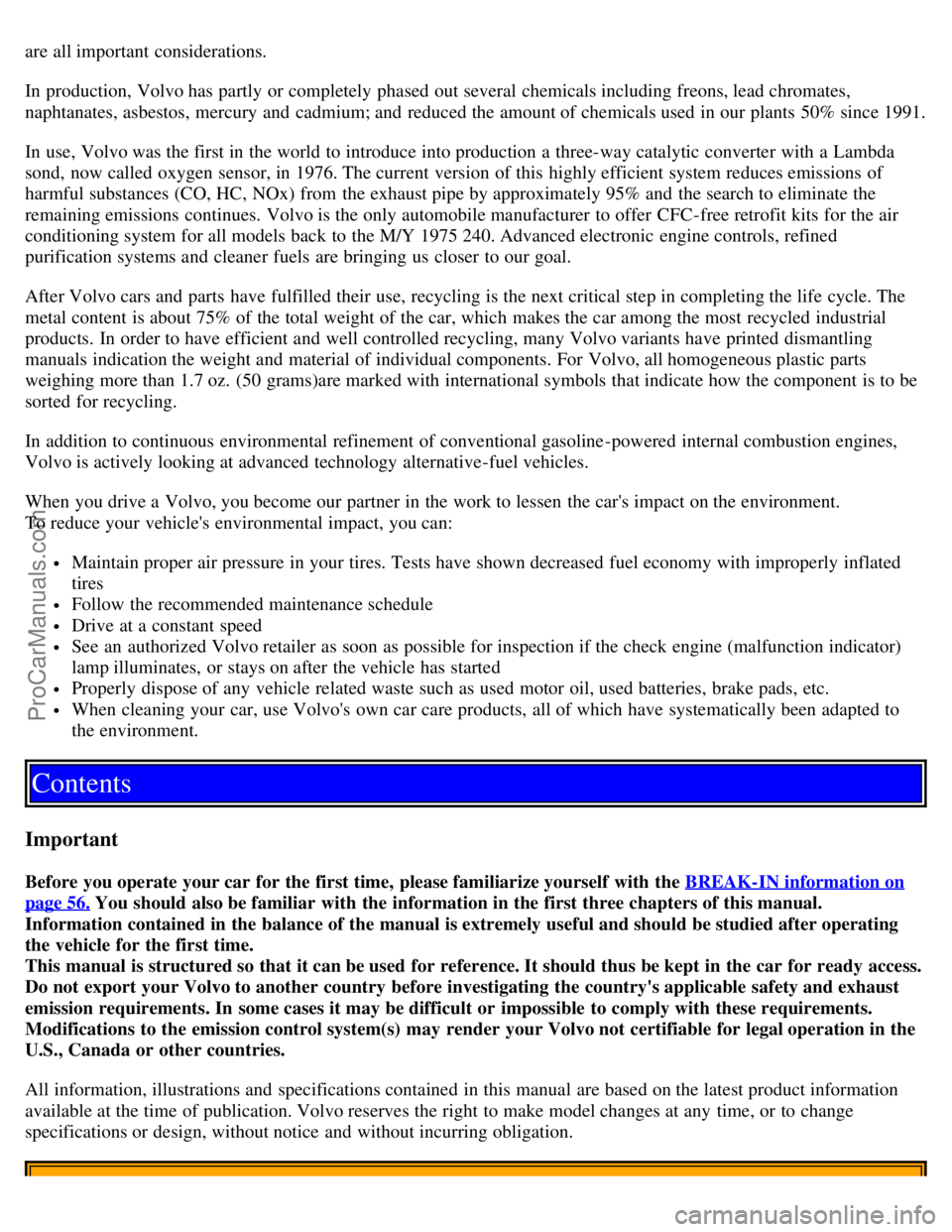check oil VOLVO C70 1998 Owners Manual
[x] Cancel search | Manufacturer: VOLVO, Model Year: 1998, Model line: C70, Model: VOLVO C70 1998Pages: 38, PDF Size: 0.71 MB
Page 2 of 38

are all important considerations.
In production, Volvo has partly or completely phased out several chemicals including freons, lead chromates,
naphtanates, asbestos, mercury and cadmium; and reduced the amount of chemicals used in our plants 50% since 1991.
In use, Volvo was the first in the world to introduce into production a three-way catalytic converter with a Lambda
sond, now called oxygen sensor, in 1976. The current version of this highly efficient system reduces emissions of
harmful substances (CO, HC, NOx) from the exhaust pipe by approximately 95% and the search to eliminate the
remaining emissions continues. Volvo is the only automobile manufacturer to offer CFC-free retrofit kits for the air
conditioning system for all models back to the M/Y 1975 240. Advanced electronic engine controls, refined
purification systems and cleaner fuels are bringing us closer to our goal.
After Volvo cars and parts have fulfilled their use, recycling is the next critical step in completing the life cycle. The
metal content is about 75% of the total weight of the car, which makes the car among the most recycled industrial
products. In order to have efficient and well controlled recycling, many Volvo variants have printed dismantling
manuals indication the weight and material of individual components. For Volvo, all homogeneous plastic parts
weighing more than 1.7 oz. (50 grams)are marked with international symbols that indicate how the component is to be
sorted for recycling.
In addition to continuous environmental refinement of conventional gasoline-powered internal combustion engines,
Volvo is actively looking at advanced technology alternative-fuel vehicles.
When you drive a Volvo, you become our partner in the work to lessen the car's impact on the environment.
To reduce your vehicle's environmental impact, you can:
Maintain proper air pressure in your tires. Tests have shown decreased fuel economy with improperly inflated
tires
Follow the recommended maintenance schedule
Drive at a constant speed
See an authorized Volvo retailer as soon as possible for inspection if the check engine (malfunction indicator)
lamp illuminates, or stays on after the vehicle has started
Properly dispose of any vehicle related waste such as used motor oil, used batteries, brake pads, etc.
When cleaning your car, use Volvo's own car care products, all of which have systematically been adapted to
the environment.
Contents
Important
Before you operate your car for the first time, please familiarize yourself with the BREAK-IN information on
page 56. You should also be familiar with the information in the first three chapters of this manual.
Information contained in the balance of the manual is extremely useful and should be studied after operating
the vehicle for the first time.
This manual is structured so that it can be used for reference. It should thus be kept in the car for ready access.
Do not export your Volvo to another country before investigating the country's applicable safety and exhaust
emission requirements. In some cases it may be difficult or impossible to comply with these requirements.
Modifications to the emission control system(s) may render your Volvo not certifiable for legal operation in the
U.S., Canada or other countries.
All information, illustrations and specifications contained in this manual are based on the latest product information
available at the time of publication. Volvo reserves the right to make model changes at any time, or to change
specifications or design, without notice and without incurring obligation.
ProCarManuals.com
Page 15 of 38

Chapter 4 - Starting and driving
pg. 55 Starting and driving
Starting and driving
This section on starting and driving contains items such as starting the engine, operating the gear selector, towing,
trailers, etc.
Break-in period
56
Fuel requirements, Refueling56-57
Driving economy58
Starting the engine59
Manual transmission60
Automatic transmission61
Points to remember64
Emergency towing66
Vehicle towing information67
Jump starting68
Three-way catalytic converter69
Brake system, ABS70
Trailer towing71
Winter driving72
Long distance trips73
pg. 56 Break-in period, Fuel requirements
A new car should be broken -in
Refrain from utilizing your car's full driving potential during the first 1,200 miles (2,000 km) including the "kick -
down" function (automatic transmission).
NOTE - ENGINE OIL:
Although some oil consumption occurs during normal engine operation, more oil is consumed when the engine is new
as the internal parts generate higher friction while wearing-in to each other. From the time the engine is new until
the first service is performed, the oil consumption could be higher than normal. For this reason, it is especially
important to check the oil every time you refuel your car during this period. See page 114
.
In general, the rate of oil consumption depends on such factors as: engine temperature, length of trip, driving
conditions, oil viscosity and quality, engine speed and acceleration/deceleration.
Checking your engine oil level each time the car is refueled is one of the most important items you can perform to
help keep your car in good running order.
ProCarManuals.com
Page 36 of 38

ECC - Electronic Climate Control........34,35Electrical system......................64,128Electrically heated front seats............30Electrically operated front seats.......46,47Electrically operated sun roof.............41Electrically-operated windows..............36Emergency towing...........................66Emergency warning flashers.................23Engine....................................125Engine compartment........................121Engine oil........................114,115,124Engine oil - checking/changing............114Engine oil pressure........................17
F
Fog light - rear........................17,22Fog lights - front.........................22Front courtesy lights......................49Front fog lights...........................22Front seats................................46Front seats - heated.......................30Front seats - memory function..............46Front suspension..........................126Fuel gauge.................................16Fuel level.................................17Fuel requirements..........................56Fuel system...............................126Fuel tank cover - opening............15,37,57 opening manually.........................97Fuses................................91,92,93Fuses - replacing..........................91
G
Gas tank cover - opening.............15,37,57 opening manually.........................97Generator..............................17,128Generator warning light....................18
H
Hand brake.................................30Handling...................................65Hazard warning flashers....................23Headlight wiper blades - replacing.........96Headlights.................................20Heated front seats.........................30Heated side -view mirrors...................23Heating....................................35Heating and air conditioning...............33High beams.................................17Hoisting the car..........................110Hood.......................................51
I
Ignition switch............................21Instrument illumination....................22Instruments.............................14,15
J
Jack.................................53,82,83Jump starting..............................68
K
Keyless entry system.......................43Keylock....................................59Keys.......................................42Kick -down..................................61
L
ProCarManuals.com